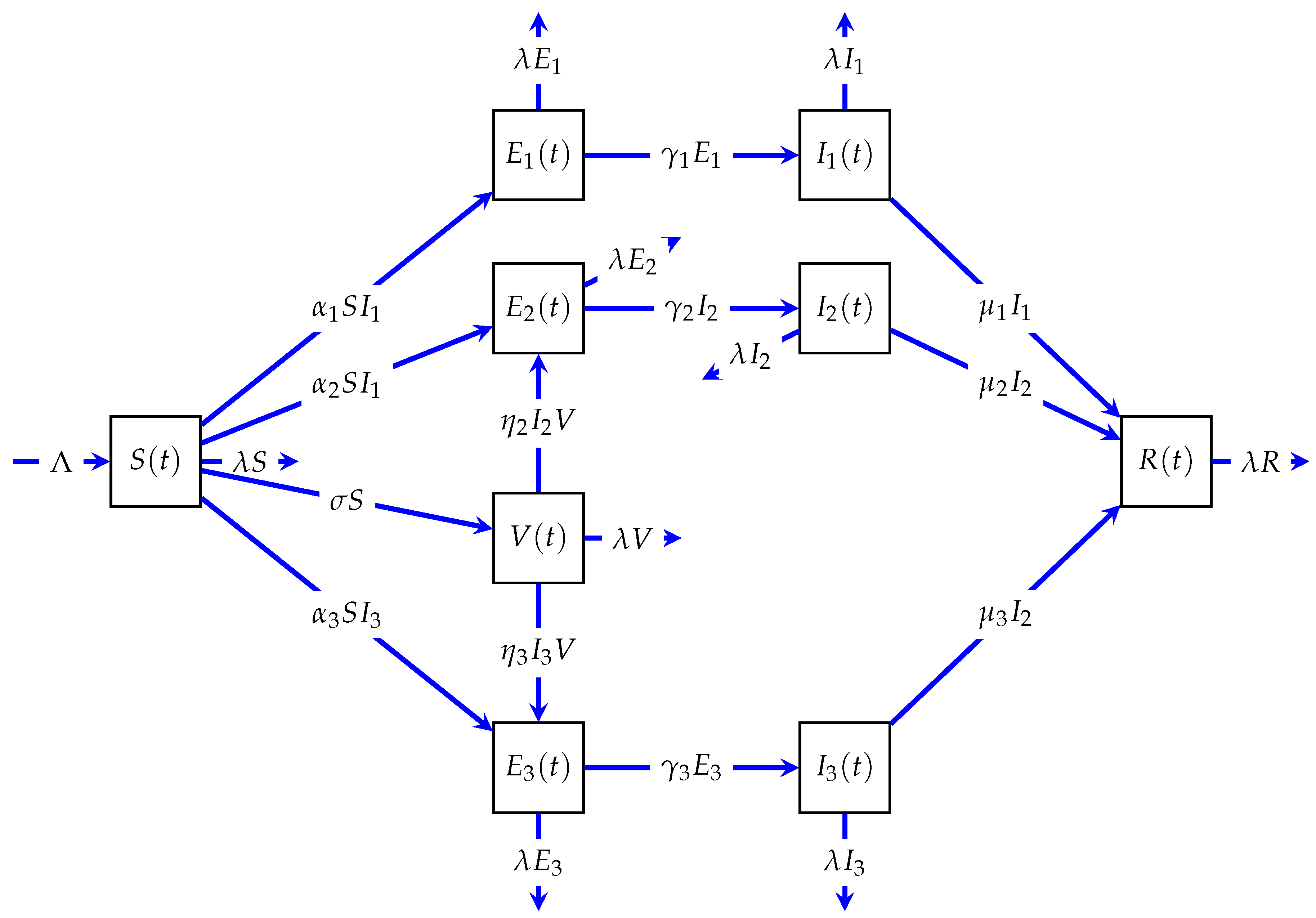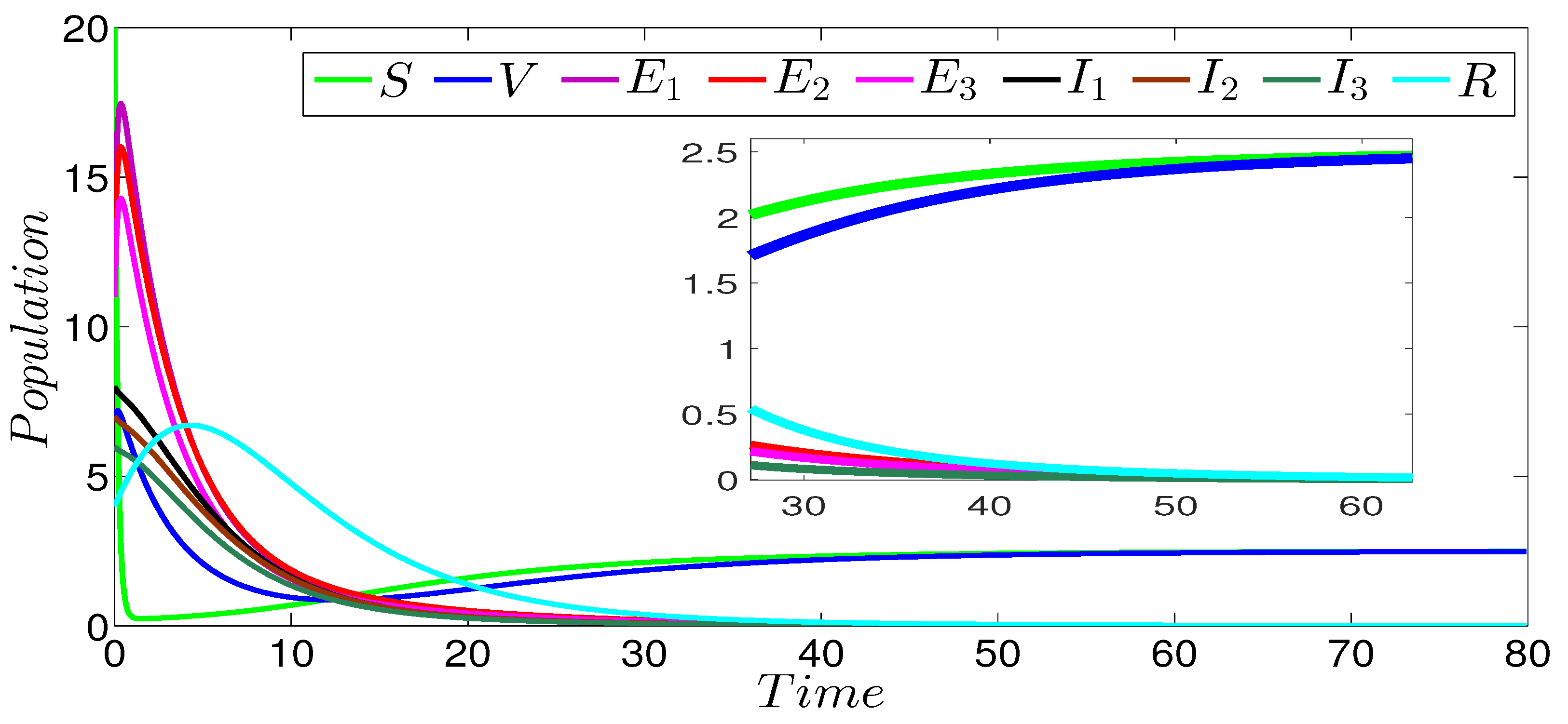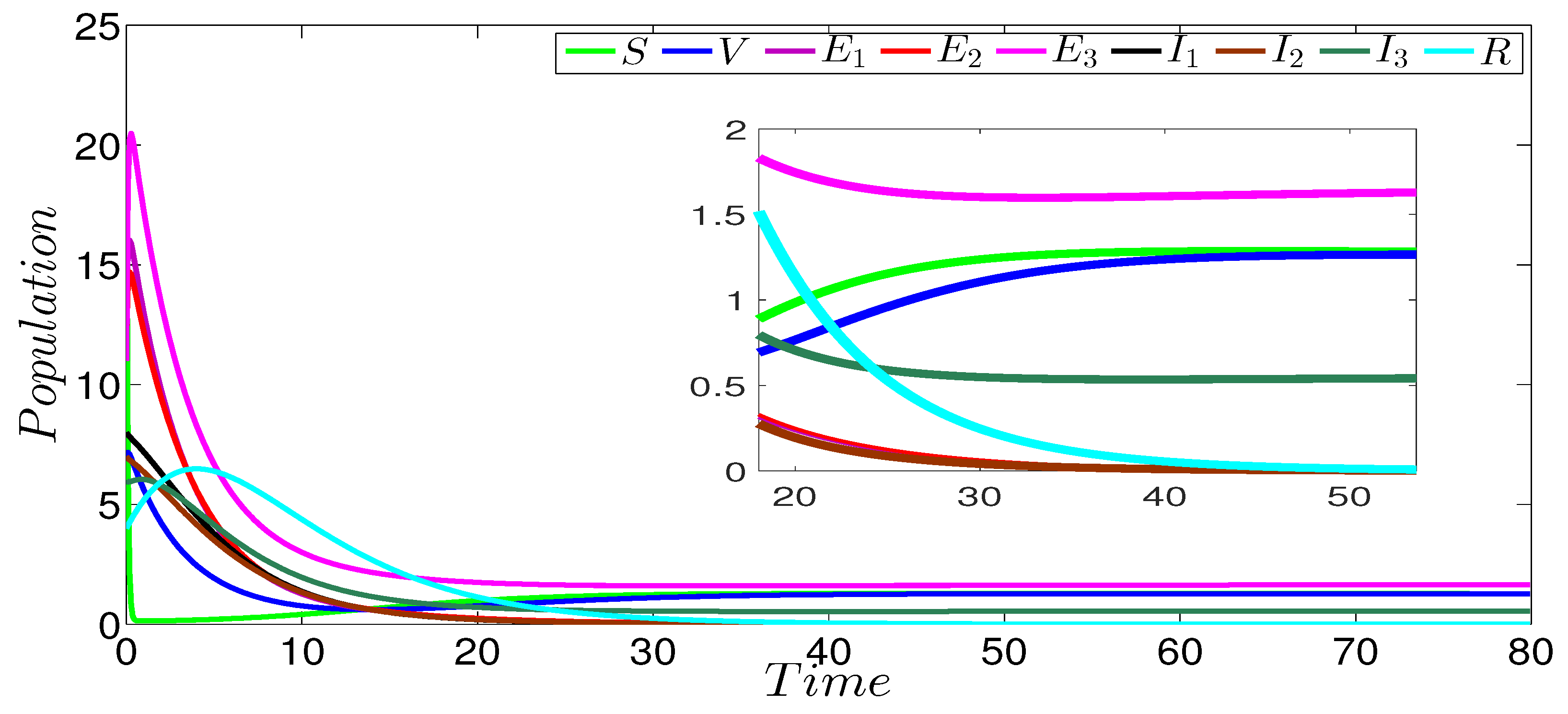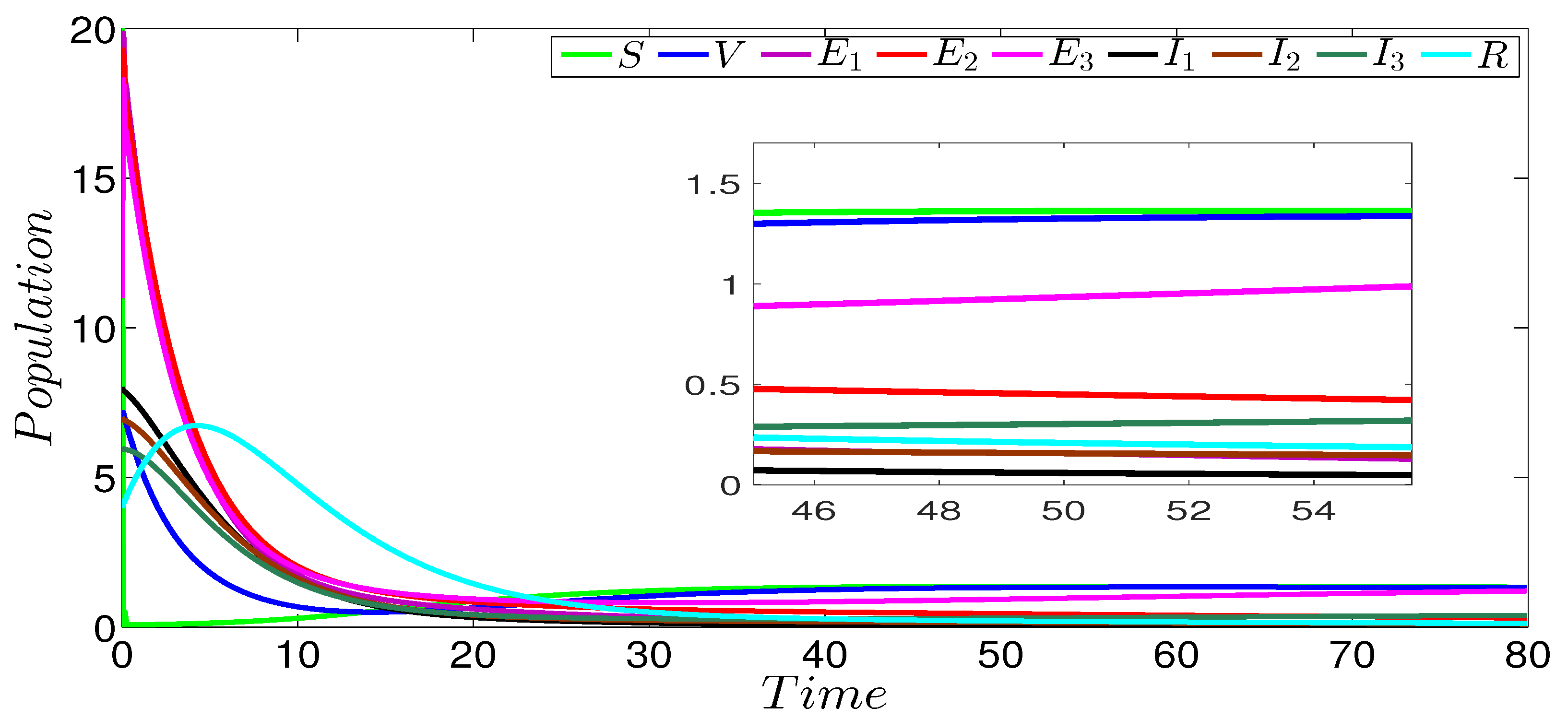Global Stability of Multi-Strain SEIR Epidemic Model with Vaccination Strategy
Abstract
1. Introduction
2. Existence, Positivity, and Boundedness of Solutions
3. Analysis of the Model
3.1. The Basic Reproduction Number Calculation
3.2. Steady States
- The disease-free equilibrium , where
- The strain-1 endemic equilibrium , where
- The strain-2 endemic equilibrium , wherewhere is solution of the equation with .
- The strain-3 endemic equilibrium , wherewhere is solution of the equation with .
- The total strain endemic equilibrium , wherewhere and are the roots of the following equations:andwhere
3.3. Global Stability
4. Numerical Simulations
5. Conclusions
Author Contributions
Funding
Conflicts of Interest
References
- Arruda, E.F.; Das, S.S.; Dias, C.M.; Pastore, D.H. Modelling and optimal control of multi strain epidemics, with application to COVID-19. PLoS ONE 2021, 16, e0257512. [Google Scholar] [CrossRef] [PubMed]
- Khyar, O.; Allali, K. Global dynamics of a multi-strain SEIR epidemic model with general incidence rates: Application to COVID-19 pandemic. Nonlinear Dyn. 2020, 102, 489–509. [Google Scholar] [CrossRef] [PubMed]
- Chen, W.; Tuerxun, N.; Teng, Z. The global dynamics in a wild-type and drug-resistant HIV infection model with saturated incidence. Adv. Differ. Equ. 2020, 2020, 1–16. [Google Scholar] [CrossRef]
- Amine, S.; Allali, K. Dynamics of a time-delayed two-strain epidemic model with general incidence rates. Chaos Solitons Fractals 2021, 153, 111527. [Google Scholar]
- Sweilam, N.H.; AL–Mekhlafi, S.M. Optimal control for a time delay multi-strain tuberculosis fractional model: A numerical approach. IMA J. Math. Control. Inf. 2019, 36, 317–340. [Google Scholar] [CrossRef]
- Kermack, W.O.; McKendrick, A.G. A contribution to the mathematical theory of epidemics. Proc. R. Soc. Lond. Ser. A 1927, 115, 700–721. [Google Scholar]
- Godio, A.; Pace, F.; Vergnano, A. SEIR modeling of the Italian epidemic of SARS-CoV-2 using computational swarm intelligence. Int. J. Environ. Res. Public Health 2020, 17, 3535. [Google Scholar] [CrossRef] [PubMed]
- Rangasamy, M.; Chesneau, C.; Martin-Barreiro, C.; Leiva, V. On a novel dynamics of SEIR epidemic models with a potential application to COVID-19. Symmetry 2022, 14, 1436. [Google Scholar] [CrossRef]
- Marinca, B.; Marinca, V.; Bogdan, C. Dynamics of SEIR epidemic model by optimal auxiliary functions method. Chaos Solitons Fractals 2021, 147, 110949. [Google Scholar] [CrossRef]
- Bajiya, V.P.; Tripathi, J.P.; Kakkar, V.; Wang, J.; Sun, G. Global dynamics of a multi-group SEIR epidemic model with infection age. Chin. Ann. Math. Ser. B 2021, 42, 833–860. [Google Scholar] [CrossRef]
- Paul, S.; Mahata, A.; Ghosh, U.; Roy, B. Study of SEIR epidemic model and scenario analysis of COVID-19 pandemic. Ecol. Genet. Genom. 2021, 19, 100087. [Google Scholar] [CrossRef] [PubMed]
- Weinstein, S.J.; Holl, M.S.; Rogers, K.E.; Barlow, N.S. Analytic solution of the SEIR epidemic model via asymptotic approximant. Phys. D Nonlinear Phenom. 2020, 411, 132633. [Google Scholar] [CrossRef] [PubMed]
- Upadhyay, R.K.; Pal, A.K.; Kumari, S.; Roy, P. Dynamics of an SEIR epidemic model with nonlinear incidence and treatment rates. Nonlinear Dyn. 2019, 96, 2351–2368. [Google Scholar] [CrossRef]
- Qiu, X.; Nergiz, A.I.; Maraolo, A.E.; Bogoch, I.I.; Low, N.; Cevik, M. The role of asymptomatic and presymptomatic infection in SARS-CoV-2 transmission—A living systematic review. Clin. Microbiol. Infect. 2021, 27, 511–519. [Google Scholar] [CrossRef] [PubMed]
- Wang, J.J.; Zhang, J.Z.; Jin, Z. Analysis of an SIR model with bilinear incidence rate. Nonlinear Anal. Real World Appl. 2010, 11, 2390–2402. [Google Scholar] [CrossRef]
- Junhua, C.; Shengjun, W. Modeling and analyzing the spread of worms with bilinear incidence rate. In Proceedings of the 2009 Fifth International Conference on Information Assurance and Security, Xi’an, China, 18–20 August 2009; IEEE: Piscataway, NJ, USA, 2009; Volume 2, pp. 167–170. [Google Scholar]
- Roy, M.; Pascual, M. On representing network heterogeneities in the incidence rate of simple epidemic models. Ecol. Complex. 2006, 3, 80–90. [Google Scholar] [CrossRef]
- Li, J.H.; Cui, N.; Niu, L.; Zhang, J. Dynamic analysis of an SEIS model with bilinear incidence rate. In Proceedings of the 2011 International Conference on Computer Science and Network Technology, Harbin, China, 24–26 December 2011; IEEE: Piscataway, NJ, USA, 2011; Volume 4, pp. 2268–2271. [Google Scholar]
- Liu, S.; Zhang, L.; Zhang, X.B.; Li, A. Dynamics of a stochastic heroin epidemic model with bilinear incidence and varying population size. Int. J. Biomath. 2019, 12, 1950005. [Google Scholar] [CrossRef]
- Kuddus, M.A.; McBryde, E.S.; Adekunle, A.I.; Meehan, M.T. Analysis and simulation of a two-strain disease model with nonlinear incidence. Chaos Solitons Fractals 2022, 155, 111637. [Google Scholar] [CrossRef]
- Meehan, M.T.; Cocks, D.G.; Trauer, J.M.; McBryde, E.S. Coupled, multi-strain epidemic models of mutating pathogens. Math. Biosci. 2018, 296, 82–92. [Google Scholar] [CrossRef]
- Sardar, T.; Ghosh, I.; Rodó, X.; Chattopadhyay, J. A realistic two-strain model for MERS-CoV infection uncovers the high risk for epidemic propagation. PLoS Neglected Trop. Dis. 2020, 14, e0008065. [Google Scholar] [CrossRef]
- Khatua, A.; Pal, D.; Kar, T.K. Global Dynamics of a Diffusive Two-Strain Epidemic Model with Non-Monotone Incidence Rate. Iran. J. Sci. Technol. Trans. A Sci. 2022, 46, 859–868. [Google Scholar] [CrossRef]
- Bentaleb, D.; Amine, S. Lyapunov function and global stability for a two-strain SEIR model with bilinear and non-monotone incidence. Int. J. Biomath. 2019, 12, 1950021. [Google Scholar] [CrossRef]
- Meskaf, A.; Khyar, O.; Danane, J.; Allali, K. Global stability analysis of a two-strain epidemic model with non-monotone incidence rates. Chaos Solitons Fractals 2020, 133, 109647. [Google Scholar] [CrossRef]
- Yaagoub, Z.; Danane, J.; Allali, K. Global Stability Analysis of Two-Strain SEIR Epidemic Model with Quarantine Strategy. In Nonlinear Dynamics and Complexity; Springer: Cham, Switzerland, 2022; pp. 469–493. [Google Scholar]
- El-Shabasy, R.M.; Nayel, M.A.; Taher, M.M.; Abdelmonem, R.; Shoueir, K.R. Three wave changes, new variant strains, and vaccination effect against COVID-19 pandemic. Int. J. Biol. Macromol. 2022, 204, 161–168. [Google Scholar] [CrossRef] [PubMed]
- De León, U.A.P.; Avila-Vales, E.; Huang, K.L. Modeling COVID-19 dynamic using a two-strain model with vaccination. Chaos Solitons Fractals 2022, 157, 111927. [Google Scholar] [CrossRef] [PubMed]
- Tchoumi, S.Y.; Rwezaura, H.; Tchuenche, J.M. Dynamic of a two-strain COVID-19 model with vaccination. Results Phys. 2022, 39, 105777. [Google Scholar] [CrossRef] [PubMed]
- Guo, J.; Wang, S.M. Threshold dynamics of a time-periodic two-strain SIRS epidemic model with distributed delay. AIMS Math. 2022, 7, 6331–6355. [Google Scholar] [CrossRef]
- Chang, Y.C.; Liu, C.T. A Stochastic Multi-Strain SIR Model with Two-Dose Vaccination Rate. Mathematics 2022, 10, 1804. [Google Scholar] [CrossRef]
- Angeli, M.; Neofotistos, G.; Mattheakis, M.; Kaxiras, E. Modeling the effect of the vaccination campaign on the COVID-19 pandemic. Chaos Solitons Fractals 2022, 154, 111621. [Google Scholar] [CrossRef] [PubMed]
- Marinov, T.T.; Marinova, R.S. Adaptive SIR model with vaccination: Simultaneous identification of rates and functions illustrated with COVID-19. Sci. Rep. 2022, 12, 1–13. [Google Scholar] [CrossRef]
- Lin, L.; Zhao, Y.; Chen, B.; He, D. Multiple COVID-19 waves and vaccination effectiveness in the united states. Int. J. Environ. Res. Public Health 2022, 19, 2282. [Google Scholar] [CrossRef]
- Kayanja, A.; Abola, B.; Kikawa, C.; Oyo, B.; Ssematimba, A. Modelling the transmission dynamics of a multi-strain SARS-CoV-2 epidemic with vaccination for an emerging strain. Res. Sq. 2022. [Google Scholar] [CrossRef]
- Bugalia, S.; Tripathi, J.P.; Wang, H. Mutations make pandemics worse or better: Modeling SARS-CoV-2 variants and imperfect vaccination. arXiv 2022, arXiv:2201.06285. [Google Scholar]
- El Hajji, M.; Albargi, A.H. A mathematical investigation of an “SVEIR” epidemic model for the measles transmission. Math. Biosc. Eng. 2022, 19, 2853–2875. [Google Scholar] [CrossRef] [PubMed]
- Shoaib, M.; Anwar, N.; Ahmad, I.; Naz, S.; Kiani, A.K.; Raja, M.A.Z. Intelligent networks knacks for numerical treatment of nonlinear multi-delays SVEIR epidemic systems with vaccination. Int. J. Mod. Phys. B 2022, 36, 2250100. [Google Scholar] [CrossRef]
- Xu, J. Global dynamics for an SVEIR epidemic model with diffusion and nonlinear incidence rate. Bound. Value Probl. 2022, 2022, 1–13. [Google Scholar] [CrossRef]
- Nasution, H.; Khairani, N.; Ahyaningsih, F.; Alamsyah, F. Mathematical modeling of the spread of corona virus disease 19 (COVID-19) with vaccines. AIP Conf. Proc. 2022, 2659, 110009. [Google Scholar]
- Sun, D.; Li, Y.; Teng, Z.; Zhang, T.; Lu, J. Dynamical properties in an SVEIR epidemic model with age-dependent vaccination, latency, infection, and relapse. Math. Methods Appl. Sci. 2021, 44, 12810–12834. [Google Scholar] [CrossRef]
- Onwubuya, I.O.; Madubueze, C.E. SVEIR model of an infectious disease among infected immigrants with nonlinear incidence rate. J. Niger. Soc. Math. Biol. 2021, 4, 1–18. [Google Scholar]
- Baba, I.A.; Kaymakamzade, B.; Hincal, E. Two-strain epidemic model with two vaccinations. Chaos Solitons Fractals 2018, 106, 342–348. [Google Scholar] [CrossRef]
- Macías-Díaz, J.E.; Raza, A.; Ahmed, N.; Rafiq, M. Analysis of a nonstandard computer method to simulate a nonlinear stochastic epidemiological model of coronavirus-like diseases. Comput. Methods Programs Biomed. 2021, 204, 106054. [Google Scholar] [CrossRef]






| Parameters | Description |
|---|---|
| The recruitment rate of the population | |
| The natural mortality rate | |
| The infection rate of strain-1 | |
| The infection rate of strain-2 | |
| The infection rate of strain-3 | |
| The vaccination rate of the strain-1 individuals | |
| The transmission rate of vaccinated individuals to strain-2 | |
| The transmission rate of vaccinated individuals to strain-3 | |
| The average latency period of the strain-1 | |
| The average latency period of the strain-2 | |
| The average latency period of the strain-3 | |
| The average infection period of the strain-1 | |
| The average infection period of the strain-2 | |
| The average infection period of the strain-3 |
Disclaimer/Publisher’s Note: The statements, opinions and data contained in all publications are solely those of the individual author(s) and contributor(s) and not of MDPI and/or the editor(s). MDPI and/or the editor(s) disclaim responsibility for any injury to people or property resulting from any ideas, methods, instructions or products referred to in the content. |
© 2023 by the authors. Licensee MDPI, Basel, Switzerland. This article is an open access article distributed under the terms and conditions of the Creative Commons Attribution (CC BY) license (https://creativecommons.org/licenses/by/4.0/).
Share and Cite
Yaagoub, Z.; Allali, K. Global Stability of Multi-Strain SEIR Epidemic Model with Vaccination Strategy. Math. Comput. Appl. 2023, 28, 9. https://doi.org/10.3390/mca28010009
Yaagoub Z, Allali K. Global Stability of Multi-Strain SEIR Epidemic Model with Vaccination Strategy. Mathematical and Computational Applications. 2023; 28(1):9. https://doi.org/10.3390/mca28010009
Chicago/Turabian StyleYaagoub, Zakaria, and Karam Allali. 2023. "Global Stability of Multi-Strain SEIR Epidemic Model with Vaccination Strategy" Mathematical and Computational Applications 28, no. 1: 9. https://doi.org/10.3390/mca28010009
APA StyleYaagoub, Z., & Allali, K. (2023). Global Stability of Multi-Strain SEIR Epidemic Model with Vaccination Strategy. Mathematical and Computational Applications, 28(1), 9. https://doi.org/10.3390/mca28010009








